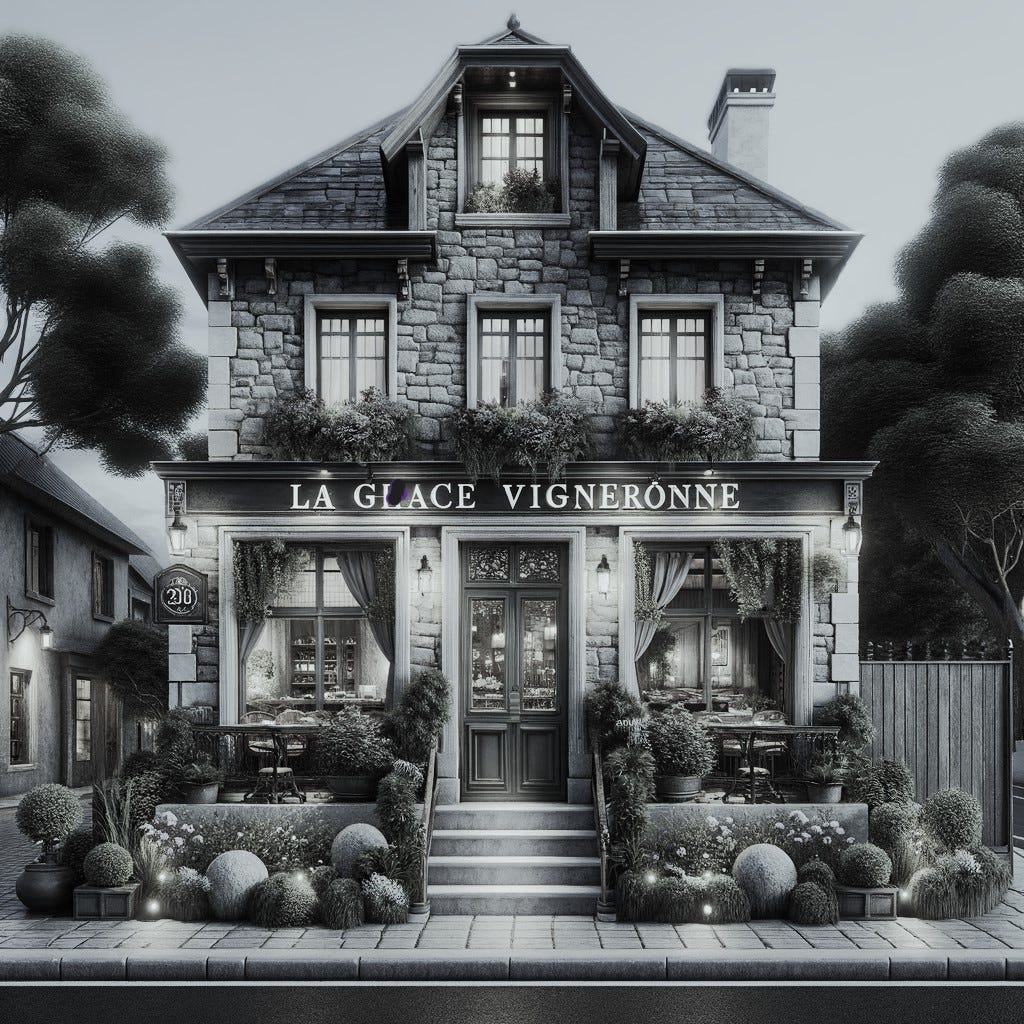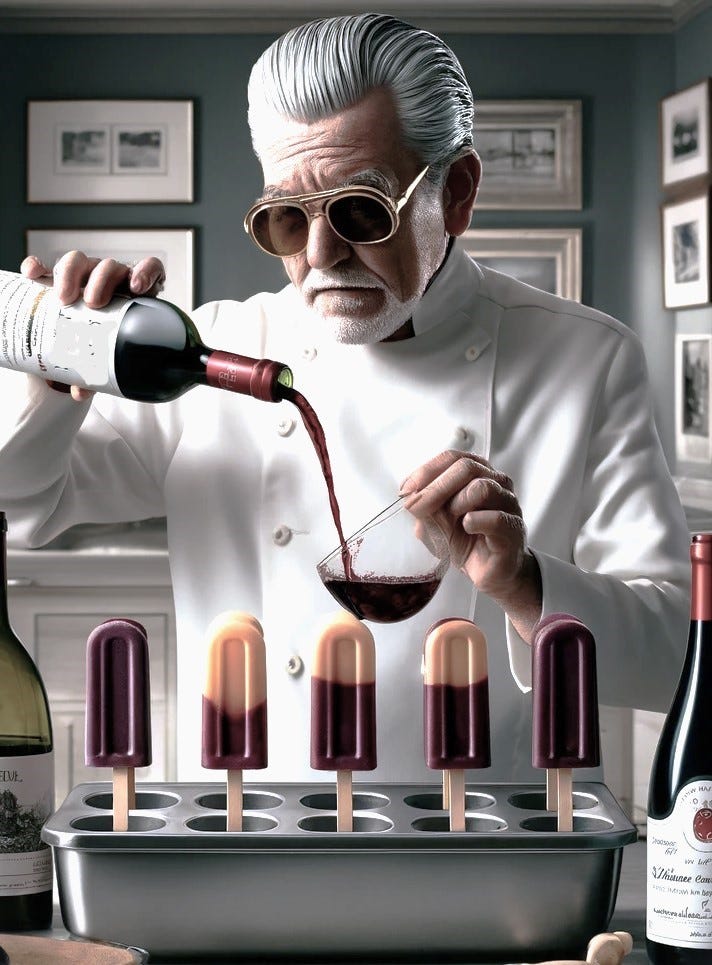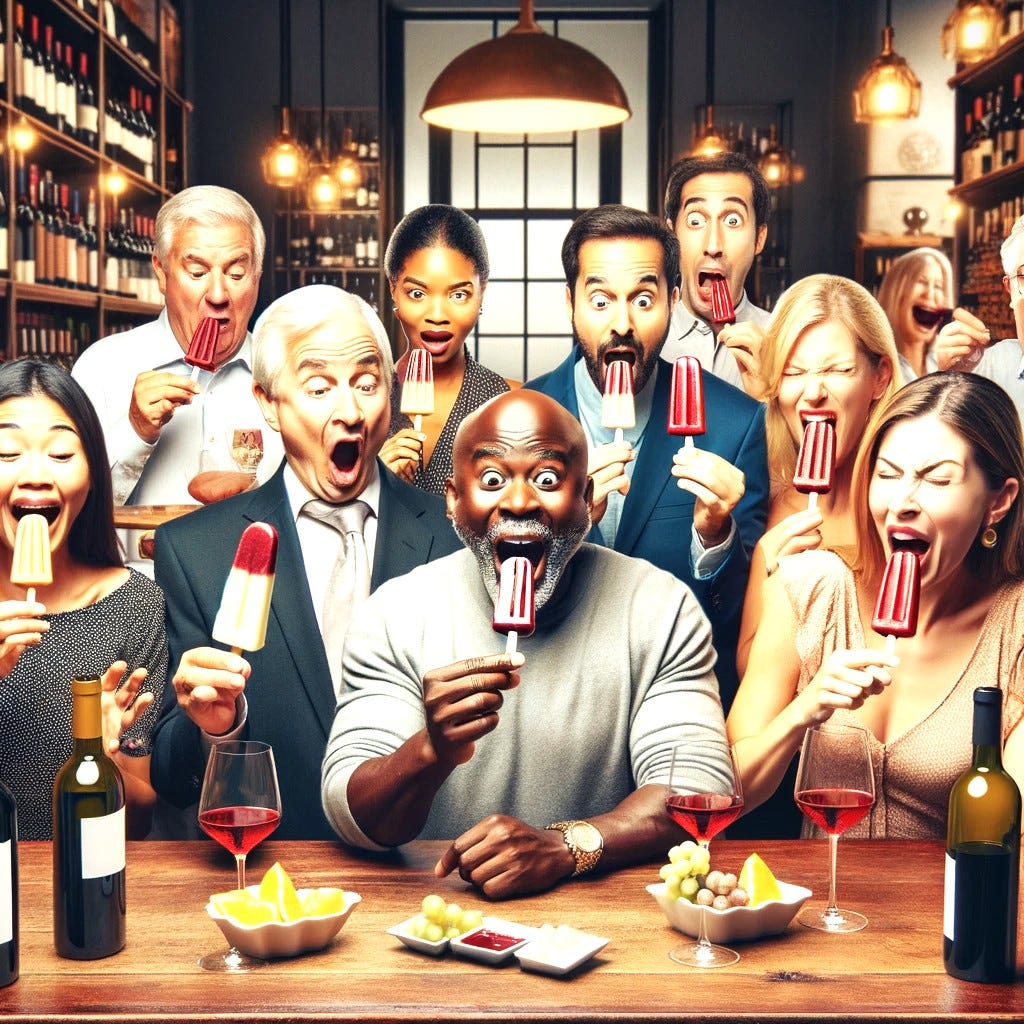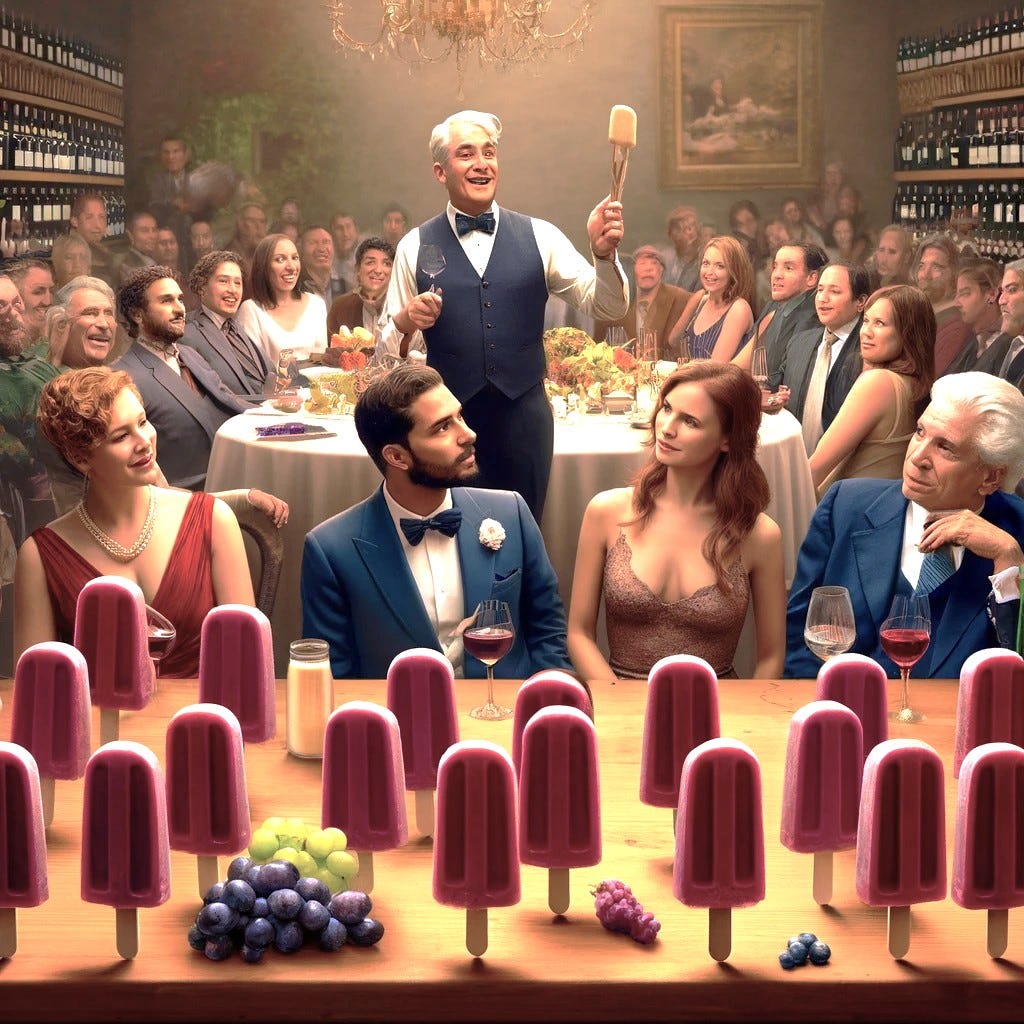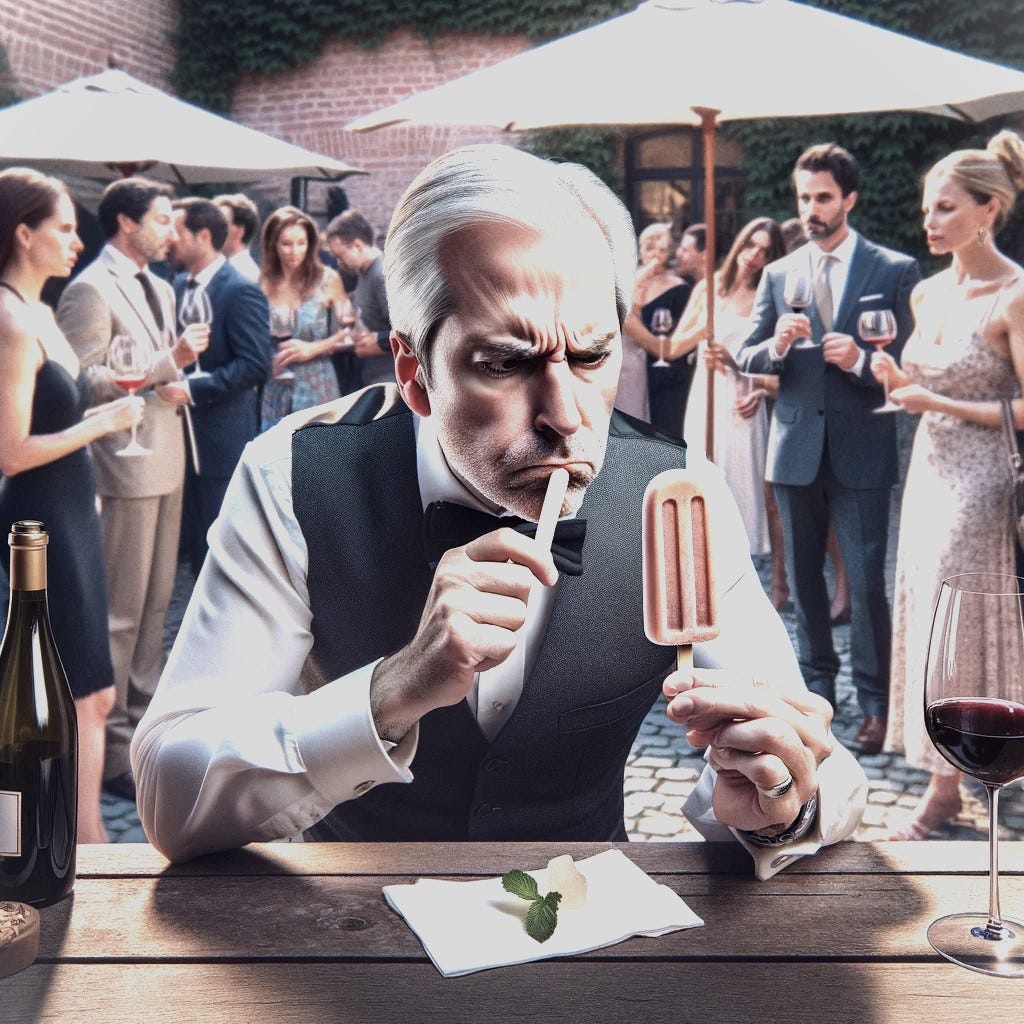La Glace Vigneronne: Chicago
The Grand Cru Popsicle Revolution
In a culinary, visionary, legendary commentary that's fantastically, contrary to the conventional cookbook's arbitrary quackery, we encounter a Chef who drastically mixes the unmixable, fixes the unfixable, blends the unbendable with flair so commendable, sparking a dependable rebellious revolution of the Popsicle that's delectably, perplexingly, sensationally stickable.
Under the leadership of Chef-Patron Jean-Luc Pétillant, the team at “La Glace Vigneronne” are embracing a bold concept that blurs the line between the tested traditions and the Antarctic avant-garde.
Introducing the Grand Cru Popsicle and the brain freeze that accompanies it.
Chef Pétillant, a maverick known for his penchant to push the boundaries of traditional gastronomy, recently unveiled a creation that has since sent shockwaves through the wine and food community. He has created a method to transform fine wine into popsicle sticks. He calls them “Winesicles,” and this week has released his most daring yet - the Domaine Romanée-Conti Popsicle set.
The journey to this audacious innovation was inspired, in part, by historical precedents that challenged wine conventions, such as Robert Mondavi's fabled use of Château d'Yquem in sorbet.
But this time, has Chef Pétillant gone a step too far, turning these and other revered wines into an entire menu at his destination restaurant?
Let’s take a look at how wine has been used in the kitchen and why
White wine has been a staple in culinary practices for centuries, valued for its ability to enhance the flavor of a wide range of dishes. It is commonly used in deglazing pans to create flavorful sauces and in poaching to impart subtle flavors to fish and bird.
Red wine's rich and robust flavors make it a favorite for cooking, particularly in traditional dishes like Beef Bourguignon. This classic French stew, popularized by Julia Child in the United States, involves slow-cooking beef in red wine with vegetables, creating a dish with complex, layered flavors. Red wine reductions are also common, used to create rich sauces that enhance the taste of meats and vegetables.
Sweet, fortified wine is often used in reductions for its rich, caramelized flavor. Chefs use it in sauces for meats and desserts, particularly those involving chocolate, to add depth and complexity.
Sherry has a broad range of flavors from dry to sweet. Its versatility makes it suitable for both savory and sweet dishes. Classic uses include sherry vinaigrettes, sherry-glazed meats, sherry-glazed fish, sherry-glazed vegetables and sherry-infused desserts like sherry-based trifles.
What exactly is a Popsicle and why is it what it is that it is?
Well, in the year 1905, 11-year-old whipper-snapper Frank Epperson accidentally left a mixture of soda powder and water outside on a cold night. The next morning, he found the mixture frozen with the stir stick inside, creating the first popsicle. Epperson began making these frozen treats for friends and later for his children, eventually patenting the idea in 1923 under the name "Epsicle," which his children later renamed "Popsicle".
The Winesicle Making Process
The method behind these opulent ice pops is as meticulous as it is extravagant. It begins with the careful reduction of some of the world's most esteemed wines, a process that concentrates their flavors without sacrificing the nuance and complexity that make them legendary.
This reduction is then blended with a secret mixture of mineral water sourced from the untouched springs of the French Alps and an artisanal secret, simple syrup, handcrafted from rare, heirloom sugar beets.
At a price point that would make an Oligarch blink, these Grand Cru Winesicles are not for the faint of heart or wallet. Each one is handcrafted with the precision and care one might expect from a Michelin-starred kitchen, and as so, they command a price commensurate with their pedigree.
La Glace Vigneronne offers a singular tasting experience or a choice of "flights" of Winesicles, allowing the truly adventurous to sample the range.
Chef Pétillant can also create these frozen fancies from your favorite bottle on request.
Purists decry it as an affront to the sanctity of the world's most esteemed wines, likening it to "Michelin service on a paper plate, in a paper restaurant."
Meanwhile, the unconventional gastronome has embraced the idea, praising its ingenuity and the way it challenges the conventions of wine appreciation.
They take the stance that wine, like any art form, is meant to evolve, to push boundaries and to challenge conventional perceptions. The tactile pleasure of holding a Winesicle, the slow, melty or “smelty” reveal of complex flavors is all part of an experiential journey. "It's not about diluting tradition," Welland Partley says, "but about freezing it in time, in the most literal sense."
In response, we would ask, “who on earth is Welland Partley and how did he get into my article?”
Others might say that it is heresy, "turning the nectar of the gods into a lollipop is akin to painting a beauty mole onto the left cheek of the Mona Lisa," exclaimed one paranoid sommelier, who wishes to remain anonymous for fear of assassination. “Wine is poetry in bottle and not freezer fodder.”
What of the reaction from Chef Pétillant himself?
"Wines have die-hard fans just like any art, sport or music, let us just say I have had death-threats. A black Range Rover has been parked in front of my house for a few weeks now, it is my car but that’s not the point." Chef explains.
“All of the great innovators were ridiculed and hounded, followed and shouted at by strangers and their closest friends. Everyone from Edison to Pasteur, I see it as a complement, they believe that I am a genius. Am I? I would say, yes, I am. But perhaps that is up to you to say.”
So, innovation or end times?
What's undeniable is that a conversation about the boundaries of food and wine has been ignited, traditionalists have been challenged and more questions than answers have presented themselves. For example, why on earth am I writing this?
As the world watches, one can't help but wonder what's next.
From vine to freezer, from bottle to stick, the journey of wine continues to unfold in ways as unpredictable as they are enthralling, leaving us to wonder what the next course will bring in this crazy world of the Indelible Wine Stain.


